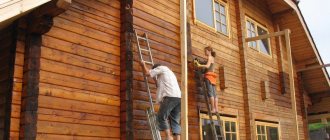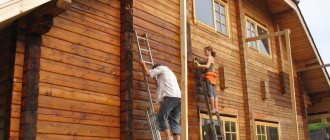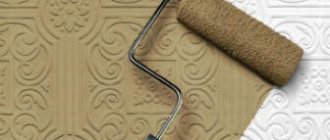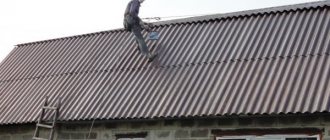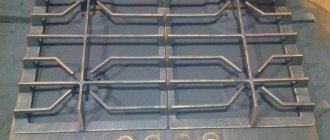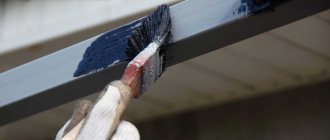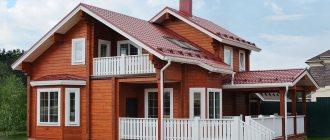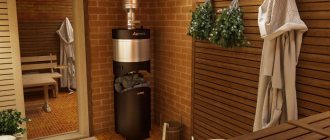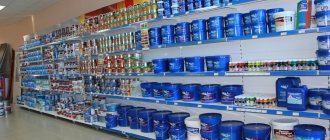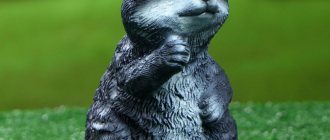Environmental friendliness in the construction of private cottages is gaining increasing popularity. For this reason, wooden facades are no longer uncommon. Everyone knows that wood has a beautiful texture and is at the same time a very difficult material to use. In this article we will tell you how to preserve the strength of natural wood and protect it from the harmful effects of the external environment. Let's figure out why impregnations are required and what paint is best to paint a wooden house. Let us describe the technology for carrying out measures for processing a wooden facade, taking into account previous operation.
What paint is best to paint a wooden house?
Why protect wooden facades
It doesn’t matter whether the house is clad with construction boards using a curtain wall system or is entirely assembled from timber, the wood used in outdoor decoration requires protection. There are objective reasons for this; any wooden material has the following unattractive properties:
- easy flammability and excellent flammability;
- porosity and, as a result, moisture saturation;
- deformation under the influence of different temperatures;
- exposure to fungus and mold, as well as bugs and pests.
Wood damaged by mold requires treatment
Unprotected wood dries out over time, loses its attractive texture and color (turns gray), becomes loose, and therefore not durable. That is why the wood on the facade should be protected from the following factors:
- effects of UV rays;
- high humidity;
- insect pests.
In order to enhance the natural excellent characteristics of wood, and at the same time reduce risk factors for unpleasant situations, wood is impregnated with special compounds and treated with paints and varnishes.
Painted wall of a wooden house
Impregnations
Primer solutions or impregnations can be used as a preparation material for painting, or can also be used as a finishing material. There are 3 types of primers:
- antibacterial (from fungus and mold);
- flame retardants (from fire);
- water-repellent.
Since it is difficult to give preference to only one method of protection, fire-bioprotection compositions have been developed that include 2 mechanisms. Water-repellent primers generally protect against UV rays and strengthen wood.
On a note! All primers have a short lifespan as a topcoat. Therefore, without further painting, facade treatment will have to be carried out regularly every 2-3 years.
Primer treatment is a simple and mandatory process when processing a wooden facade.
Impregnation treatment will not only improve the appearance, but also increase the service life of the wood. For facade work, you should choose deep penetration compositions on an organic basis. Such solutions are usually toxic and have a characteristic unpleasant odor. When working with them, PPE (personal protective equipment) is used: gloves, goggles, respirator.
On a note! Most primers have a transparent base, which means that treatment with this composition will preserve the natural grain and color of the wood.
Prices for glaze impregnation for wood
Glaze impregnation for wood
Facade paints
Any paintwork material used for facade work must have a certain set of qualities. But in the situation with wood, this list increases, due to the natural vulnerability of the tree.
Characteristics that any façade material should have:
- resistance to precipitation of various temperatures;
- resistance to temperature changes;
- coating color stability;
- abrasion resistance;
- resistance to mechanical and physical influences;
- chemical inertness.
Facade paints can be successfully combined: wood protection and an interesting design solution
When it comes to painting a wooden facade, the paint requirements are supplemented by the following criteria:
- Plastic. Wood is a breathable, flexible material. Logs and boards can change volume depending on temperature and changes in humidity levels. Therefore, the decorative coating material must also be elastic and not crack.
- Vapor permeability. Decorative material should not create a barrier for moisture to escape from the body of the wall in order to prevent the onset of rotting.
- Fire safety. The material itself must not only protect the wood from burning, but also be non-flammable.
Most wood paints have a rich color palette
On a note! When choosing paint for painting a wooden facade, you should pay attention to the antistatic properties of the material. A paint coating with a high index will accumulate less dust and fine dirt, which means the façade will be much easier to maintain.
Prices for various types of paint for wooden facades
Paint for wooden facades
Classification of coatings for facades
Essentially, when choosing a paint, you select the type of future surface that will be obtained after applying the material to the wood. For exterior use, all paints are classified according to the type of solvent, the resulting texture and quality of gloss.
Gloss
Matte or shiny surface is not only beauty. Glossy coatings are more durable because they contain more resins. Matte surfaces are usually obtained from breathable decorative compounds. In addition, the glossy finish is more resistant to moisture and less susceptible to abrasion.
Manufacturers indicate the gloss level of the final coating on the can with a number ranging from 0 to 100. It is customary to divide the gloss level into 6 main groups.
Variety of colors for wooden facades
Table 1. Gloss levels.
| Digit range | Reflectivity |
| from 0 to 5 | matte without reflection effect |
| from 5 to 10 | matte with low reflection |
| from 10 to 30 | semi-matte have some shine |
| from 30 to 60 | semi-gloss with medium gloss level |
| from 60 to 90 | glossy with shine effect |
| from 90 to 100 | super shiny |
Solvent
All types of paints are diluted with 3 types of solvent:
- water, the compositions are called water-dispersed;
- organic chemistry, such as white spirit, acetone, solvent;
- inorganic compounds.
White Spirit
Paints diluted with inorganic compounds are rarely used in everyday life. For wooden facades, materials are usually used that are diluted to the desired consistency with water, as well as enamels, varnishes, alkyd and oil paints. The specificity of organic solvents is their unpleasant odor.
On a note! Water-dispersed materials can only be applied at positive temperatures. Paints diluted with organic compounds can be used even with a slight minus.
Texture
Facade paints come in textured (volumetric) and forming materials for smooth surfaces. Textured compositions are not used for wood processing, since wood initially has a rich texture and does not require additional decoration. Smooth compositions can be transparent, such as varnishes, or dense, like enamel.
Even covering with colored paint allows you to preserve the natural texture of the wood.
Useful tips
It is best to paint a new wooden house with antiseptics. If the wood is of expensive species, you should give preference to glazing compounds; if the house is made of logs of ordinary species, coating compounds can hide some of its shortcomings. They can only be applied at positive temperatures, in sunny weather. The antiseptic will be able to penetrate deeply into the structure of the wood, provided that it is well dried.
If the house has already been painted and its facade only needs to be updated, there is only one recommendation for choosing paint - it is better to use the type of paint that has already been used previously. You can determine it by the appearance of the old coating. If it has a grainy texture similar to that of real leather, the house has most likely been previously painted with acrylic paint.
To determine the type of old coating, you need to make a cut somewhere in an inconspicuous place with a knife. When the paint cracks as a result, the house was most likely previously painted with oil-based paint. When worn, the painted surface becomes mesh-like. In such a situation, it is better to completely remove all the old layers of coating and only then apply a new one. When the coating is rolled into a tube, it is acrylate paint.
Types of paints
Before you start painting the wood, you should decide what quality of façade you plan to get in the end. Modern paints and varnishes make it possible to process wood and at the same time obtain surfaces of different appearance:
- natural in color and texture, with varying degrees of gloss;
- matte with a hint of color, but maintaining texture;
- opaque and glossy.
Facade painting
Let's consider the most popular compositions, their positive qualities and some disadvantages.
Oily
The most famous compositions and the most affordable. The material completely covers the natural color, creating a dense film on the surface. It is this layer that perfectly protects the wood from moisture; the coating has almost zero absorption of any solutions. Oil paints are produced on the basis of drying oil.
This paint has a very short service life, quickly fades and begins to crack under the influence of temperature. The downside of hydrophobicity is the lack of vapor permeability, that is, the layer does not allow moisture to pass through, but also does not allow the tree to breathe, which can lead to rot within the wood mass.
Oil-based paint has a very short lifespan
Among other things, such compositions take a very long time to dry, about 10 -12 hours. They are more suitable for routine repairs of low buildings, fences or sheds, as they require regular updating.
Alkyd
Compositions formed on the basis of resins with the addition of oils. The PF marking is more understandable to a wide range of people. The composition does not penetrate inside to a sufficient depth, forming a durable film on the surface. They dry faster than oil-based compounds, but have a very unpleasant odor. They form a hydrophobic durable layer that is not subject to fading from moisture and temperature. It is this combination of qualities that makes alkyd paint very popular for treating wooden facades in regions with high humidity.
Glossy facade treated with alkyd paint
The paint loses color when exposed to direct sunlight, and over time the surface loses its gloss. If it happens that the paint was applied to damp wood, the layer will begin to bubble.
Silicone
Compositions based on organic compounds or resins. They have proven themselves well in operating conditions in humid climates. Silicone (or latex) paint coating is durable even after applying one layer. The surface has a high degree of chemical inertness; the facade can be washed with almost any means. The paint does not fade in the sun and does not fade. In addition, the coating is resistant to mechanical stress and abrasion. The main drawback is the very high price.
Matte surface of a wooden facade painted with silicone paint
In a special article we will talk in detail about the advantages of silicone paint for facades, and also consider painting technology.
Prices for popular brands of waterproof silicone paint
Waterproof silicone paint
Acrylic
Popular paints for finishing wooden facades. There are acrylic paints on sale on a water dispersion basis, that is, they are diluted with water and compositions based on an organic solvent. They have excellent adhesion, form a vapor-permeable layer that is resistant to moisture and ultraviolet radiation. That is, the coating does not fade, the color is not washed out by rain, and the wood breathes. The paint does not have an unpleasant odor and dries quickly. The protective layer is abrasion resistant and has a long service life.
On a note! Acrylic compounds are commercially available that allow repair work to be carried out even at low temperatures.
Paint can enhance the natural color of wood, making the material more durable.
Aqueous dispersions
Such paints can be silicone, silicate and acrylic; what they have in common is that they are all diluted to the desired consistency with clean water. Depending on the main substance, the price of the product can vary greatly. The advantages of such compositions include:
- absolute environmental cleanliness,
- vapor permeability of the layer,
- rich color palette,
- inertness to chemicals,
- long service life.
The paint dries very quickly and is very easy to apply.
Water-based paints have many advantages and are easy to work with.
Some shortcomings are still present. The water in the dye penetrates into the wood, so some surface mobility is expected. Before applying paint, the facade should be treated with a water-repellent primer.
How to paint a wooden facade yourself
If there is a need to paint the facade of an already used house, it is quite possible to do this work yourself. To do this, you need to take care of having free time, you will need a lot of it. Purchase consumables in advance: primer and paint in the required volume, coloring pigment (color) and solvent as needed. The approximate consumption rates of the compositions and the service life of the coating are in the table below.
Table 2. Composition consumption rates and coating service life
| Type of paintwork | Consumption (g/m²) | Service life (years) |
| Silicone | 150 — 200 | 20 or more |
| Alkyd | 100 — 120 | 20 |
| Acrylic | 130 — 200 | 15-20 |
| Oily | 100 | 2-3 |
| Water-dispersed | 110 — 130 | 20 or more |
Scaffolding is very convenient for working at heights
In order to put the facade in order, in addition to materials, you will need the following tools:
- stepladder or scaffolding,
- different brush widths,
- rags
- Angle grinder (grinder) with discs for grinding,
- putty knife,
- construction mixer with an attachment for mixing paint.
Depending on the type of paint used, you will need various personal protective equipment: gloves, a respirator, goggles.
Video - An example of incorrect painting of a wooden facade
Video description
In the video, a specialist talks about what you need to pay attention to when choosing paint for a wooden house:
If necessary, you can apply oil or alkyd paint over the glaze layer of antiseptic. If you purchased an acrylic composition for painting the facade, you will have to remove the antiseptic film right down to the wood.
Based on cost, paints are divided into three classes. Budget materials are produced by Senezh. Their products cost no more than one hundred rubles per kilogram of paints. The middle price segment is represented by the brands “Belinka” and “Tikkurila”. Their products on average across the country are estimated at 200-300 rubles per kilogram. The most expensive paints cost from 350 rubles and above. In the premium segment there are products from, Woodworks and Johnestones.
If the surface of the paint cracks like a mesh, most likely the house was painted with oil paint Source akspic.ru
Technology
The whole process takes place in 4 stages. At the same time, scrupulousness and attention are required to complete the work. It is important to do everything carefully, without leaving untreated areas.
Stage 1. Removing the old coating. This procedure is performed if there is an old paint coating. It needs to be removed. To do this, you can use spatulas, a wire brush, sandpaper or a grinder with an attachment. There will be quite a lot of dust, so you should work with glasses and a respirator.
All work is carried out in dry, not hot weather. The entire area of the facade will have to be protected, including the joints of logs or boards. In order for the work to be completed efficiently and without delay, remove the drainage elements, shutters and trim from the facade in advance. In addition to old paint, dust and street dirt should be removed from the facade.
Important! You should not leave old paint on, even if the layer sits firmly on the surface. Its service life will expire and it will peel off along with the new coating.
Before painting the facade, remove the old coating
Stage 2. After the facade is cleared of paint, the wood is sanded and puttied. If there are areas of darkening, or pockets of fungal infection are visible, the top layer of material should be removed to a clean texture. The rest of the surface is leveled. Existing defects on the surface are eliminated by puttying. Before moving on to the next steps, the putty must dry. The putty material must be compatible in composition with impregnation and paint.
The top layer of wood is cleaned and sanded
Stage 3. Deep penetration impregnation is applied to the cleaned wooden surface, the composition of which is selected depending on the characteristics that require strengthening. Typically, impregnation is applied with a wide brush along the grain to preserve and emphasize the natural texture of the wood.
Do not neglect priming; impregnation will not only improve the quality of the wood, but will increase the adhesion of paint to the surface, while reducing the amount of material consumed. Even though wood primers are quite expensive, their use is worthwhile. Before applying the paint, the impregnation must dry; the period for complete drying is indicated by the manufacturer on the packaging.
For longer service life, the wood should be impregnated with certain compounds.
Step 4. Before starting work, check the long-term weather forecast. Rain is not suitable for painting, nor is heat. In addition, work should be carried out during the daytime, when the dew has either already evaporated or has not yet settled, that is, from 10 to 18 hours. The paint is applied in several layers along the fibers. Each subsequent layer should be applied only after the previous one has dried.
To paint a wooden facade, a wide brush is usually used.
Video - Technology of painting a wooden facade
Some nuances of coloring
It would seem that the process is quite simple and transparent. But here, as everywhere else, there are nuances:
- If the facade has external metal fastening elements, then before priming and painting they should be filled with an oil or acrylic compound to match the color of the wood. This work will be especially relevant if the finishing coating is planned to be made transparent.
- If you approach the issue carefully, you can use several impregnating compounds; water-repellent impregnation is applied last.
- For better surface quality, after the impregnation has dried, the wood should be sanded to remove small roughness and lint.
You can improve the quality of a wooden surface by sanding the wood after applying the primer.
Safety rules when working with dyes
- All devices must be checked before use, they must be in full working order, and their parts must be intact.
- Before work, you need to put on overalls and gloves, protect your head, eyes and respiratory tract. Shoes should not slip. It is desirable that the sole be thicker.
- When painting a one-story building, a stepladder is required, and for multi-story buildings, installation equipment and insurance are required. It is also important to take into account weather conditions - in strong winds, work is strictly prohibited.

